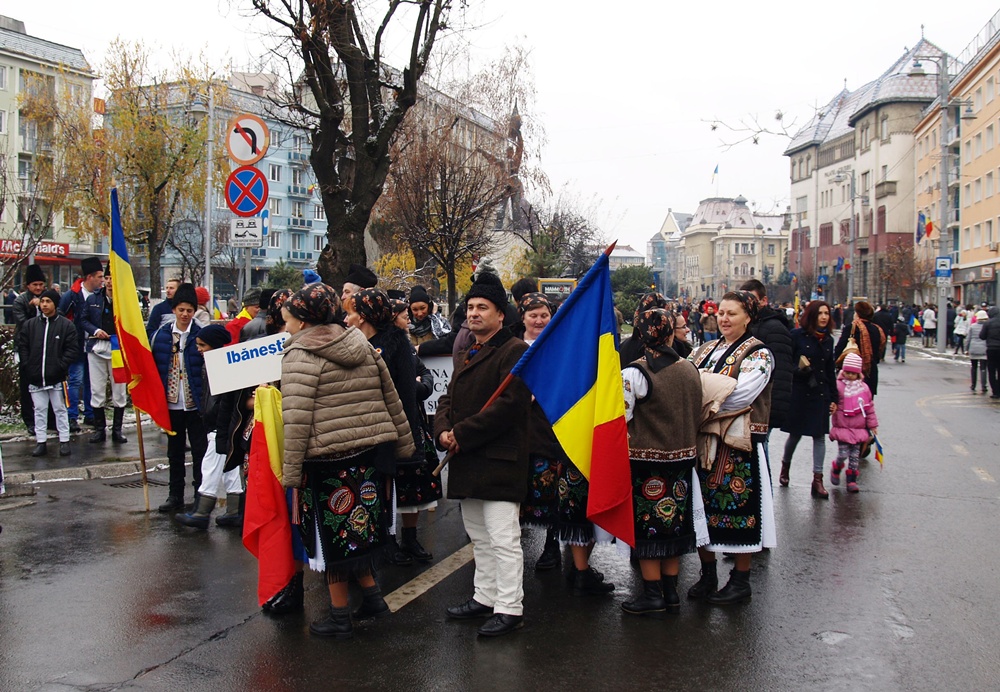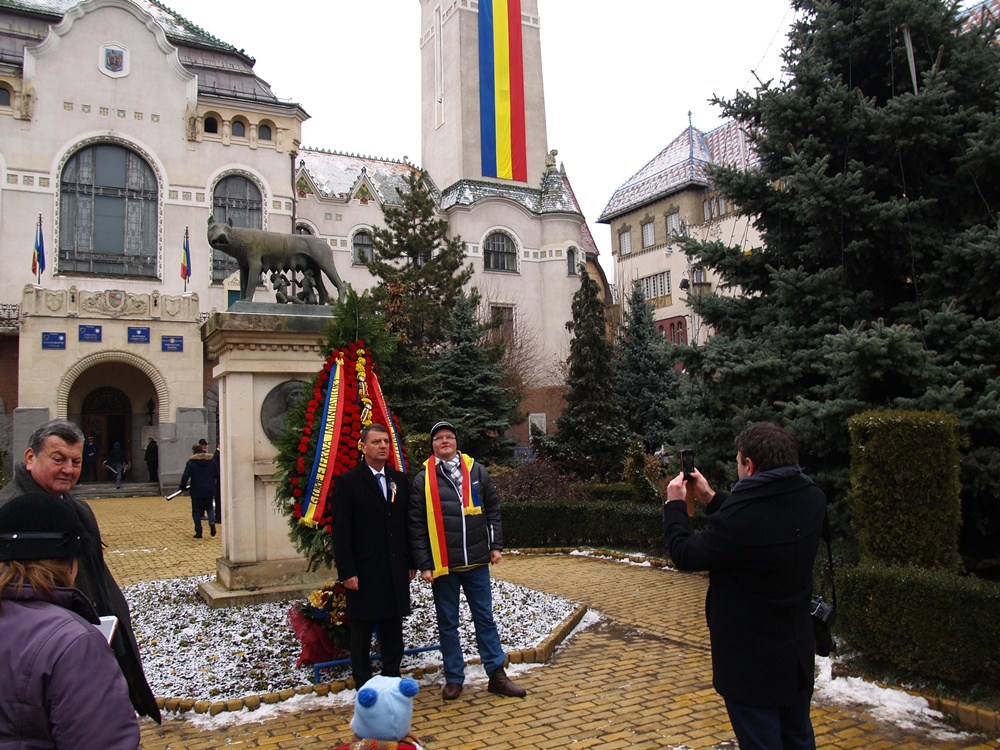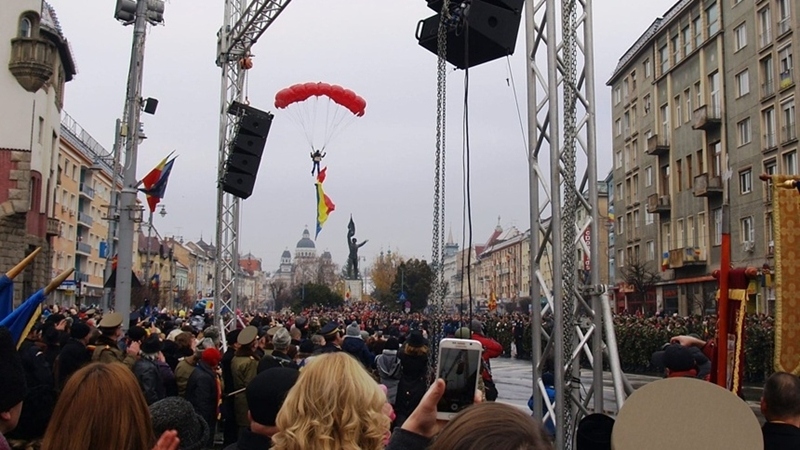The formal commemorations held no serious surprises for the interested observer. In Târgu Mures (Marosvásárhely), the official event lasted barely for 90 minutes. The solemn speeches and the church liturgy was structured by interludes of poetry recital and the landing of a parachutist on the main square, with the enormous chute in the national colors of Romania. The arrival of the parachutist led into the laying of a wreath on the statue of the she-wolf, a copy of the one found on the Capitolium in Rome and symbol of the Daco-Roman ancestry with which most Romanians identify. The ceremony ended with a military parade, where the armed forces, police, firefighters all delegated detachments, and even a motorboat full of divers was part of the defile. In sum, it was a national day celebration much like anywhere else in the world, and the slight military overtones were diffused by the evening, which featured folk dancing, a rock concert and a street fair.

The (re)-emergence of Hungarian-Romanian tensions on the occasion of the anniversary cannot be termed surprising any more than the component parts of the celebration. (Beyond these tensions, those of a domestic character were also palpable – much as in Hungary, national holidays have become intensely political in Romania, as well.) These tensions certainly fit into a broader pattern. In 1990, the first time the anniversary was celebrated, Géza Szőcs, then secretary general of the Democratic Alliance of Hungarians in Romania and a senator in the Romanian Congress was booed while on stage in Alba Iulia. In 2001, Hungarian local politicians vehemently protested the planned celebration in Miercurea Ciuc (Csíkszereda). This, in turn, incensed Romanian public opinion, which considered the protest an insult. On December 1, 2014, the anniversary was greeted by black flags hanging from buildings on the main square of Târgu Secuiesc (Kézdivásárhely), instead of the Romanian national colors. Last year the same city was visited by anti-terrorist units which allegedly prevented a planned act of terrorism by Hungarian nationalists. Finally, this year it was the instruction given to Hungarian diplomats by the minister for foreign affairs to not attend any celebrations that caused indignation on the Romanian side. The controversy was fanned by the viral dissemination, via the internet, of a short but highly “politically incorrect” speech delivered by on Orthodox Christian member of the clergy in Sfântu Gheorghe (Sepsiszentgyörgy) which referenced the “Mongol” character of Hungarians.

In view of all of the above one should not be surprised that this year saw for instance a Facebook post from former Romanian president Traian Băsescu, which called on authorities to come up with an appropriate diplomatic response to the Hungarian decision, referencing the activities of the Romanian army in Hungary in 1919 and 1944/45 in the process. This incident, beyond the unusually harsh tone used by Băsescu (even when taking into consideration that 2016 was an election year) merits consideration precisely because of the historical references. In 2018, with the centennial of Transylvania’s unification with Romania being commemorated, it is far from impossible that these could make a return in public discourse. This summer saw the establishment of a special department as part of the prime minister’s office, tasked with preparing the commemorations for the anniversary of the “great unification”. Numerous ideas and propositions have been advanced which resonate ever more with a potential next great national undertaking: the re-integration of Moldova. One thing is certain: 2018 will be a busy year for stakeholders in Romanian politics of memory and identity.

The unfolding events will certainly leave their mark on both Hungarian and Romanian public discourse. There is more at stake than one-liners thrown in the heat of campaigning (2018 will be another election year, this time in Hungary): national identities and historical consciousness will be affected by the upcoming anniversary. Campaigns are becoming ever more frequent and what is said on the campaign trail is often forgotten soon after. But some issues run deeper. The sense of comfort, of being at home could be affected for many Transylvanians, both Romanians and Hungarians. The increasing vulgarity of public discourse could disrupt their lives and their coexistence. But the same is true for judgements about the dissolution of historic Hungary – the Alba Iulia assembly and the Treaty of Trianon (1920) included. And historians will be affected, especially if the slow, but ongoing deconstruction of ethnocentric mythologies and stereotypes about the common Hungarian-Romanian past will be derailed (a common undertaking of intellectuals from both nations), while old narratives and unhistorical interpretations make a triumphant return. Then once more it will be the same old story – or stories – about “Romanian perfidy”, about the ”border at the river Tisza”, about “incurable Hungarian irredentism” and the other all too familiar clichés.

Are there lessons to be learned? At the very least, a reminder about the responsibility of historians may be in order. They must continue to talk and write about the past according to their best professional convictions and conscience. About World War I, about the events of 1918-1919, but also about antecedents and consequences. For instance, about the events of 1848, which are remembered by a large part of Romanian society as the unilateral annexation of Transylvania by Hungary, conditioning their attitudes towards the Hungarian national holiday of March 15. What is clear is that all of the above are not simply part of the „past” as such. “Alba Iulia”, “Trianon” and a host of other concepts have meanings that are in flux and need to be interpreted in the context of the World War and in that of great power and small state politics.
December 9, 2016






